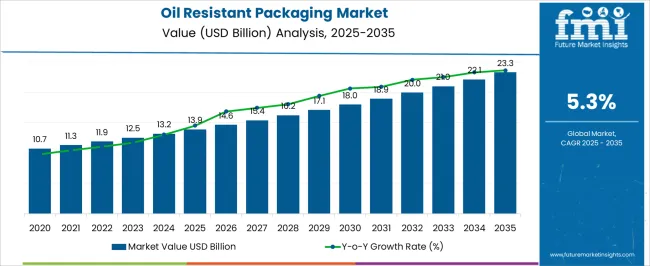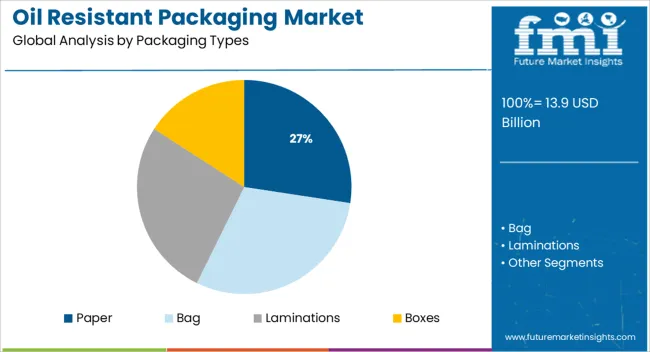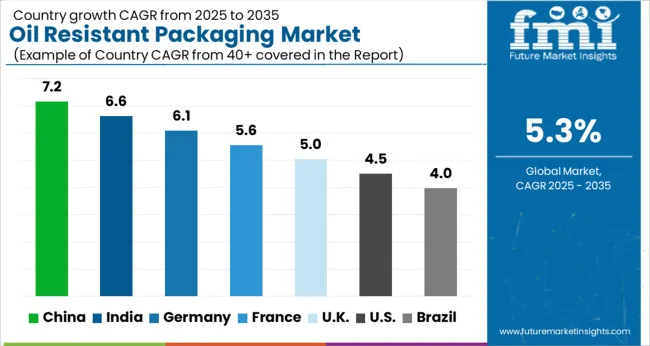The Oil Resistant Packaging Market is estimated to be valued at USD 13.9 billion in 2025 and is projected to reach USD 23.3 billion by 2035, registering a compound annual growth rate (CAGR) of 5.3% over the forecast period.

| Metric | Value |
|---|---|
| Oil Resistant Packaging Market Estimated Value in (2025 E) | USD 13.9 billion |
| Oil Resistant Packaging Market Forecast Value in (2035 F) | USD 23.3 billion |
| Forecast CAGR (2025 to 2035) | 5.3% |
The oil resistant packaging market is experiencing upward momentum as manufacturers and retailers seek effective barriers against grease and oil seepage without compromising sustainability. Regulatory pressures on plastic reduction and consumer expectations for eco-conscious packaging have accelerated the adoption of biodegradable, recyclable, and compostable materials with oil-resistant coatings. Advancements in functional coatings derived from water-based polymers, bio-waxes, and plant-based laminates are enhancing paper packaging performance, making it viable for oily food applications.
The fast-moving consumer goods and foodservice industries are driving innovation as ready-to-eat and takeaway formats grow in popularity. Packaging vendors are responding with hybrid solutions that balance resistance, printability, and recyclability.
As demand for shelf-ready packaging and direct food contact solutions expands globally, opportunities are emerging in fiber-based alternatives and multi-layered structures tailored for oil containment. The long-term outlook is shaped by continued investment in coating technologies, increasing adoption of mono-materials, and expansion in the food packaging value chain.
The market is segmented by Packaging Types and Applications and region. By Packaging Types, the market is divided into Paper, Bag, Laminations, and Boxes. In terms of Applications, the market is classified into Packed Snacks, Beverages, Confectioneries, Cosmetics, Pharmaceuticals, and Industrial. Regionally, the market is classified into North America, Latin America, Western Europe, Eastern Europe, Balkan & Baltic Countries, Russia & Belarus, Central Asia, East Asia, South Asia & Pacific, and the Middle East & Africa.

The paper subsegment is expected to account for 27.4% of the oil resistant packaging market revenue in 2025, making it the leading packaging type. This leadership has been driven by increasing adoption of sustainable alternatives to plastic packaging in the food sector. Paper, when treated with oil-resistant coatings, offers a favorable balance between functionality, sustainability, and cost efficiency.
Brands and manufacturers have increasingly relied on coated and laminated paper to meet evolving regulatory standards and consumer expectations around green packaging. Additionally, its compatibility with both flexographic and digital printing processes supports branding objectives without compromising barrier performance.
The recyclability and compostability of treated paper, especially when free from fluorochemicals, has reinforced its role in food-safe packaging. As innovation continues in aqueous and bio-based barrier technologies, the paper segment is expected to sustain its lead in oil resistant applications across various formats.

The packed snacks subsegment is projected to capture 22.4% of the total market revenue in 2025, positioning it as the dominant application area. This growth is being influenced by the rapid global expansion of snack food consumption, driven by lifestyle shifts, convenience preferences, and urbanization. Oil resistant packaging has become critical in maintaining freshness, preventing grease transfer, and ensuring visual appeal in snack packaging.
With increasing launches of fried and baked snack products, demand for flexible packaging that can contain oil without compromising barrier integrity has surged. The packed snacks segment also benefits from continuous innovation in resealable closures and portioned formats, which pair effectively with oil resistant substrates.
Retailers have emphasized the importance of maintaining pack aesthetics during transportation and shelf display, further supporting the use of advanced oil-resistant solutions. This combination of performance, compliance, and convenience is expected to uphold the segment’s leading status in the oil resistant packaging landscape.
Packaging has become a vital constituent of modern life due to the ease of transportation, storage and inclination of the consumer towards an extensive usage of bags. Moreover, food products, health supplements, and electronic components are some of the things that have witnessed improvements regarding demand over the last few years and are more readily available due to an efficient packaging solution.
Oil resistant packaging is a effective that provides all the features for packaging for commodities that produces natural oil or oily in nature. The oil resistant packaging is prepared by incorporating cyclodextrin in or adjacent to a film layer of the package to reduce the secretion of oil through the packaging material, and particularly out of the package.
Such packaging has been an excellent convenient for the masses for carrying and storing products which are greasy and oily in nature without any mess.
The growth of global oil resistant packaging market is driven by the demand for innovative packaging technologies from various end-user industries to make their products more appealing to consumers. Oil resistant packaging is mostly adopted by the food & beverage industry, fast food industries, dietary supplement industries where oil resistant packaging is used as a marketing tool by the manufacturers to make their product more appealing to consumers.
Furthermore, the demand for FMCG (Fast-moving Consumer Goods) and the changing eating habits of the consumers towards packed snacks and confectioneries are further boosting the demand for oil resistant packaging market among the manufacturers globally. On the plus side, macroeconomic factors such as the rise in disposable income of middle-class population leading to increased spending on various ready to eat products can be attributed to the growth of oil resistant packaging market globally.
Trends prominent in the oil resistant packaging is the innovations, for instance, Zanders GmbH, a leading European company in packaging has been developing oil resistant packaging for packaging which along with oil resistant will also be water, aroma protection. However, complexities associated with different types of global oil resistant packaging might hamper the growth of global oil resistant packaging market.
Based on the geographies, global oil resistant packaging market is segmented into five regions -- North America, Latin America, Europe, APAC, and the Middle East & Africa. Among the regions mentioned above, North America accounts for a significant share of oil resistant packaging market, owing to the demand for packaging technologies that garner consumer attentions among the manufacturers across the country.
Furthermore, North America packaging industry’s position in the global packaging market is bolstering growth for oil resistant packaging in the region. Moreover, the large chain of fast food industries and various other industry such as automobile industry in USA is acting as a catalyst for the growth of oil resistant packaging market in North America.
Europe market for oil resistant packaging is next to that of North America for similar trends, which is followed by Asia-pacific and Middle-East & Africa for oil resistant packaging market. Latin America market for oil resistant packaging market is anticipated to register a sluggish growth over the forecast period. Overall, the global oil resistant packaging market is projected to register a healthy growth rate by the end of forecast period.
Some of the major players identified in the global oil resistant packaging market include Zanders GmbH, Archroma, SNP, Inc., NTI, DuPont, michelman, inc., Sun Grown Packaging, Twin Rivers Paper Company profiling among others.
The research report presents a comprehensive assessment of the market and contains thoughtful insights, facts, historical data, and statistically supported and industry-validated market data. It also contains projections using a suitable set of assumptions and methodologies.
The research report provides analysis and information according to market segments such as geography, technology, and applications.

The report is a compilation of first-hand information, qualitative, and quantitative assessment by industry analysts, inputs from industry experts and industry participants across the value chain. The report provides in-depth analysis of parent market trends, macro-economic indicators and governing factors along with market attractiveness as per segments.
The report also maps the qualitative impact of various market factors on market segments and geographies.
The global oil resistant packaging market is segmented on the basis of oil resistant packaging types, applications and region.
The global oil resistant packaging market is estimated to be valued at USD 13.9 billion in 2025.
The market size for the oil resistant packaging market is projected to reach USD 23.3 billion by 2035.
The oil resistant packaging market is expected to grow at a 5.3% CAGR between 2025 and 2035.
The key product types in oil resistant packaging market are paper, bag, laminations and boxes.
In terms of applications, packed snacks segment to command 22.4% share in the oil resistant packaging market in 2025.






Full Research Suite comprises of:
Market outlook & trends analysis
Interviews & case studies
Strategic recommendations
Vendor profiles & capabilities analysis
5-year forecasts
8 regions and 60+ country-level data splits
Market segment data splits
12 months of continuous data updates
DELIVERED AS:
PDF EXCEL ONLINE
Competitive Landscape of Oil-Resistant Packaging Providers
Child-Resistant Foil Packaging Market Size and Share Forecast Outlook 2025 to 2035
Leading Providers & Market Share in Child-Resistant Foil Packaging
Oily Waste Can Market Size and Share Forecast Outlook 2025 to 2035
Oil and Gas Seal Market Size and Share Forecast Outlook 2025 to 2035
Oil Coalescing Filter Market Size and Share Forecast Outlook 2025 to 2035
Oil-immersed Iron Core Series Reactor Market Size and Share Forecast Outlook 2025 to 2035
Oil and Gas Sensor Market Forecast Outlook 2025 to 2035
Oil Packing Machine Market Forecast and Outlook 2025 to 2035
Oil and Gas Pipeline Coating Market Forecast and Outlook 2025 to 2035
Oilfield Scale Inhibitor Market Size and Share Forecast Outlook 2025 to 2035
Oil-in-Water Anionic Emulsifier Market Size and Share Forecast Outlook 2025 to 2035
Oil and Gas Field Services Market Size and Share Forecast Outlook 2025 to 2035
Oil Control Shampoo Market Size and Share Forecast Outlook 2025 to 2035
Oil Expellers Market Size and Share Forecast Outlook 2025 to 2035
Oilfield Stimulation Chemicals Market Size and Share Forecast Outlook 2025 to 2035
Oiler Kits Market Size and Share Forecast Outlook 2025 to 2035
Oil Pressure Sensor Market Size and Share Forecast Outlook 2025 to 2035
Oil Filled Power Transformer Market Size and Share Forecast Outlook 2025 to 2035
Oily Skin Control Products Market Analysis - Size and Share Forecast Outlook 2025 to 2035

Thank you!
You will receive an email from our Business Development Manager. Please be sure to check your SPAM/JUNK folder too.
Chat With
MaRIA